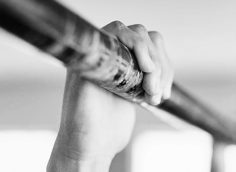The right warm-up method can make or break your workout. We're talking about the actual sets and reps performed before a big lift, not walking on a treadmill for 15 minutes or rolling around on the floor doing dynamic pre-hab corrective glute activation drills.
Depending on your goals, your warm-up may serve a variety of purposes, but here's mainly why you should be doing it:
- To prevent injury by priming the musculature that's about to be trained.
- To get you "turned on" neurologically so that your body performs the movements with more efficiency.
- To pre-exhaust the musculature being trained before even reaching the top sets.
- To allow you to practice the setup and movement – proper bar path, muscle activation, movement initiation, etc. In other words, to practice like you play.
So, where do you begin? With one simple rule:
The longer you take to warm-up on your initial movement, the better your working sets will feel, and starting with the empty bar to see how your body is feeling on that day will tell you a lot early on. Get to the point where you can tell, just by using the empty bar, whether the training session is going to be on point, average, or sucky.
Using an empty bar will allow for some instinctive regulation in regards to loading patterns, rather than just sticking to an outlined routine. If you're scheduled to do heavy-ish sets of 5 but can tell through your empty-bar warm-up that something feels tight or off, lower your intensity for the day and do more volume with a lighter load. This has saved my ass on more than one occasion in regards to avoiding injury, and it'll save yours too.
- Treat the warm-up with respect. Set up for empty bar warm-ups the same way you do for your biggest sets. In other words, set up like it's heavy.
- Treat the reps the same way as well. Yes, an empty bar will feel light. But doing kipping empty-bar reps where you're flailing all over the place is dumb. Use smooth reps. Pay attention to what your joints feel like and how your body is moving. This will give you some clues about the rest of your workout. Does it need to be adjusted? The empty bar will let you know.
- Do 2-4 sets of 20-40 reps. Yes, that's a wide range. If everything feels great after two sets, add some weight. If you still feel stiff after two sets, no one said you have to start adding weight. Take as much time as you need with the empty bar until your setup, technique, and rep execution feels dialed in.
5 Proven Warm-Up Methods
Increase the weight while lowering the reps on each successive set. After your empty bar sets, if you planned on working up to 500 x 5, it might look something like this:
- 135 x 12 reps
- 225 x 8 reps
- 315 x 5 reps
- 405 x 3 reps
- 455 x 2 reps
- Work set: 500 x 5 reps
Notice what happens here? You don't exhaust yourself on the warm-ups leading up to the working set. When using the pyramid you're looking to prime yourself for that top working set through the preceding warm-up sets.
If you're not capable of moving 500 x 5, or it's a smaller movement where your top set might only be 135 x 5 (with say barbell curls), then the jumps would obviously be smaller and would probably require fewer warm-up sets overall. For example:
- Empty bar warm-up
- 65 x 12 reps
- 95 x 8 reps
- 115 x 5 reps
- Work set: 135 x 5 reps
This is a method I like in order to both prime myself from a movement performance standpoint and to limit the amount of weight I'll be moving for the working sets.
"Why limit the amount of weight you'll be using?" Glad you asked. Because weight on the bar isn't the be-all, end-all solution to growing muscle or increasing strength. It's a tool in the toolbox. If I'm fatigued but still busting ass and going all-out on my working sets, there will be muscle growth-inducing stimulation, regardless of weight used.
With this method you'd use 5 reps across all sets, working up to the top set. This would be 8 sets of 5 reps across all sets.
- Empty bar warm-up
- 135 x 5
- 185 x 5
- 225 x 5
- 315 x 5
- 365 x 5
- 405 x 5
- 455 x 5
- 500 x 5
If you want to have a lot of fun – and by fun, I mean making this really hard – then keep rest periods to a minimum between sets, making the top set as difficult as possible by the time you get there. This is usually a set/rep method I prefer for bigger movements like squats, pressing, deadlifting, etc. that you can make decent weight jumps on before getting to your big sets.

If you spent ample time warming up properly to bench press, then you go to incline dumbbell presses, you don't need to go back through the process of warming-up all over again. You just need to acclimate to the new movement and get on with it. Acclimation sets are warm-up sets that are done for exercises after the initial movement of the training session. Basically you use them to acclimate to new movement transition, priming the body for the new movement.
Acclimation sets are done well shy of failure and only serve the purpose of movement transition. So if you did bench presses and were now starting incline dumbbell press and planned on hitting the 100's for an all-out set of max reps, you'd only need two acclimation sets beforehand:
- Acclimation – 50's x 6 reps
- Acclimation – 80's x 4 reps
- Get busy – 100's x max reps
Feeder sets are essentially half warm-up sets and half working sets. They're another form of pre-exhaustion and priming for the working/top sets. With feeder sets you're going to take those sets near failure, but not to absolute failure, before you reach the top set.
Feeder sets are great for people who like to use a lower volume of work in regards to "top sets" but will accrue real working volume over the course of building to that top set. Another way of looking at these is that they're warm-ups done after your warm-ups, just with more effort.
Feeder sets also follow the pyramid method. So for the top set of 500 x 5 again, this is how it might look:
- Empty bar warm-up
- Normal warm-up – 135 x 12
- Normal warm-up – 225 x 8
- 315 x 5 reps
- Feeder set 1 – 365 x 3 reps shy of failure
- Feeder set 2 – 405 x 2 reps shy of failure
- Feeder set 3 – 455 x 1 rep shy of failure
- Work set – 500 x 5 or more reps
In this example, the lifter would actually accrue a lot of volume on whatever movement was being done. However, he would be saving his total effort to failure or target reps for the last set. Technically, it's still just one set on paper for a top set. However, the feeder sets are still work. This is a marvelous way to get in volume without actually going all-out until the last set.
This makes back-off sets more efficient. Over warm-ups are when you work PAST the weight you plan on doing for your main work set(s), then come back to it. So in the 500 x 5 example, we'd actually go past 500 pounds but for minimal reps, often only a single, then go back to 500 pounds. It would look something like this:
- Empty bar warm-up
- 135 x 12
- 225 x 8
- 315 x 5
- 405 x 3
- 455 x 2
- 500 x 1
- Over warm-up - 550 x 1
- Back-off set – 500 x 5
Neurologically, you may find that moving a heavier weight for even a single rep here may allow you to do more reps with the back-off set than if you had just worked up to it alone. The 500 will feel a lot lighter after the 550 than it would by just warming up to the 500 in pyramid fashion. That's kind of a "duh" statement, but the impact on set performance is fairly profound, so it's worth mentioning.
Remember that your warm-up should be treated with respect and done with efficiency. The difference in a great training session and a shitty one can often be narrowed down to how much time and effort you put into proper warm-up sets. Don't rush them and you'll put in the best work possible while minimizing the chance of injury.





